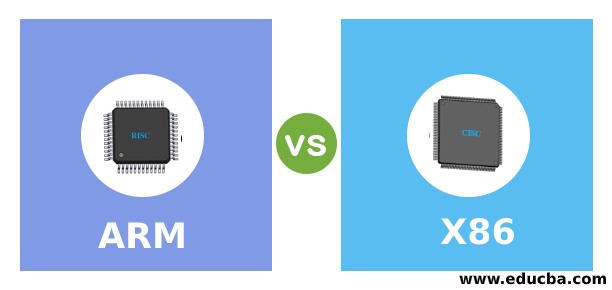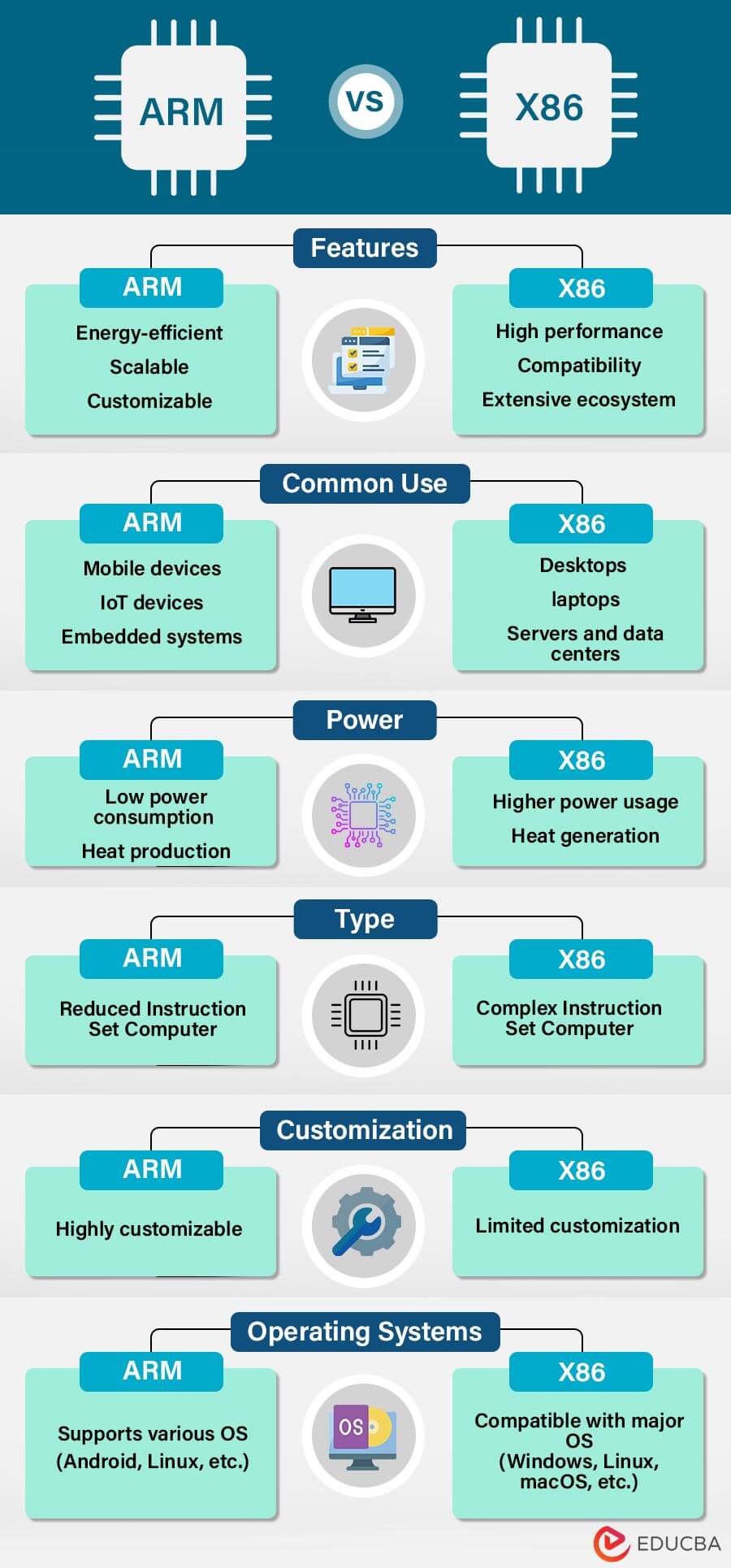
Difference Between ARM vs X86
The following article provides an outline of ARM vs X86. X86 Refers to the Intel processors’ family starting from 8086, and it later releases 80186, 80286, 80386, 80486, Pentium, Xeon, etc. mber 86 in X86 denotes the last 2 digits of its earlier processors. ARM originally started as Acorn RISC Machine by ARM Holdings, developed ARM, ARM2 32 bit processors with minimal transistors that had lower power consumption/heat dissipation. X86 dominates desktops, workstation, laptop and server markets, and initial chips were 16 bits, and later versions were 32 and 64 bits. ARM edged out Intel processors in speed and long battery life. Collaborated with Apple and VLSI to float a new company, Advanced RISC Machines. ARM processors are extensively used in mobile devices.
Head-to-Head Comparison Between ARM vs X86 (Infographics)
Below are the top 13 differences between ARM vs X86:

Key Difference Between ARM and X86
Let us discuss some of the major key differences between ARM vs X86:
X86 and ARM are the two major Processors hogging the CPU market, and each has its own strengths and weakness.
They can be compared on certain key aspects like instruction sets they adopt, power consumption, software, and application.
Instruction Set
- ARM processors belong to Reduced Instruction set computing (RISC) Architecture.
- Instruction set architecture (ISA) defines the way instructions are processed, memory is accessed, IO is managed, and it connects Processor with a programmer for generating efficient code.
- RISC is the latest of its kind in which activities are split (reduced) into simple instructions, one instruction is executed in one clock cycle, and millions of such instructions are crunched in a second at a faster rate.
- Though it has to execute multiple instructions, overall speed is higher due to its powerful processors and pipelining.
- Whereas X86 processers follow Complex Instruction set computing (CISC) architecture.
- Complex instructions are processed in a single step in multiple clock cycles. It handles multiple instructions in a single step using the available memory, focusing more on process efficiency.
- It uses more registers to complete multiple tasks and achieves high throughput and performance.
Power Consumption
- ARM processer executes one instruction at a time, and it requires less hardware. No of the registers used by this processor is less when compared to others. Hence, it consumes less power, and the device’s battery life that uses this processor is higher. It also generates less heat. ARM uses more memory to process multiple instructions. It consumes 5W power even when GPUs and other peripherals are used.
- X86 processors focus more on performance and high throughputs and use more registers to achieve it. Hence the power consumption and heat generation are more here. Intel i7, a high-end processor, consumes 130w of power.
- ARM processors are preferred in mobile devices due to their lower power consumption and long battery life, which are paramount in selecting CPUs for any application.
- Devices always connected to a reliable power source need not worry about power consumption, and hence, desktops, laptops, and servers use X86 for its efficiency at the cost of high power consumption.
Software
- Devices fitted with ARM Process runs on Android Operating systems developed exclusively for ARM. Desktops, laptops, and servers run on OS like Unix, Linux, and Windows developed for X86 processors.
- Some interfacing software allows any OS to run on any devices, but the ARM-based system has limitations to run in some OS developed for X86.
- Because of ARM’s popularity, Microsoft has released a new version of Windows for ARM.
Application
- The selection of Processors depends on the application for which the computer is going to be used. For IOT applications, the ARM processor is the right choice because the embedded system needs to be connected to all equipment and should be small.
- ARM is the best choice if some application needs a single-board computer with a cost-saving motive. ARM is the ideal choice for frugal applications where exotic displays are not needed. For an application that needs a powerful platform, X86 is the right choice.
ARM vs. X86 Comparison Table
Let’s discuss the top comparison between ARM and X86:
| ARM | X86 |
|
Uses Reduced Instruction Set Computing Architecture (RISC). |
Uses Complex Instruction Set computing Architecture (CISC). |
| Executes single instruction per cycle. | Executes complex instruction at a time, and it takes more than a cycle. |
| Optimization of performance with software-focused approach. | Hardware approach to optimize performance. |
| Requires fewer registers and more memory. | It uses more registers and less memory |
| The pipelining of instructions is a unique feature. | Less pipelined. |
| Faster Execution of Instructions reduces time. | The time to execute is more. |
| Complex addressing is managed by software. | Inherently designed to handle complex addresses. |
| Compiler plays a key role in managing operations. | The microprogram does the trick. |
| Multiple Instructions are generated from a complex one and executed individually. | Its Architecture is capable of managing complex statement execution at a time. |
| Managing code expansion is difficult. | Code expansion is managed easily. |
| The decoding of instruction is handled easily. | Decoding is handled in a complex way. |
| Uses available memory for calculations. | Needs supplement memory for calculations. |
| Deployed in mobile devices where size, power consumption, and speed matter. | Deployed in Servers, Desktops, and Laptops where high performance and stability matter. |
Conclusion
The selection of Processors depends on the application requirement and the level of performance expected. ARM is most preferred in high-end, modern, and digital application devices, as opposed to X86. Low-end, conventional back-end applications prefer X86, where robust performance is required.
Recommended Articles
This is a guide to ARM vs X86. Here we discuss the ARM vs X86 key differences with infographics and comparison table. You may also have a look at the following articles to learn more –

